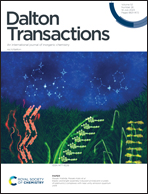Catalytic activation of remote alkenes through silyl-rhodium(iii) complexes†
Abstract
The tandem isomerization–hydrosilylation reaction is a highly valuable process able to transform mixtures of internal olefins into linear silanes. Unsaturated and cationic hydrido-silyl-Rh(III) complexes have proven to be effective catalysts for this reaction. Herein, three silicon-based bidentate ligands, 8-(dimethylsilyl)quinoline (L1), 8-(dimethylsilyl)-2-methylquinoline (L2) and 4-(dimethylsilyl)-9-phenylacridine (L3), have been used to synthesize three neutral [RhCl(H)(L)PPh3] (1-L1, 1-L2 and 1-L3) and three cationic [Rh(H)(L)(PPh3)2][BArF4] (2-L1, 2-L2 and 2-L3) Rh(III) complexes. Among the neutral compounds, 1-L2 could be characterized in the solid state by X-ray diffraction showing a distorted trigonal bipyramidal structure. Neutral complexes (1-L1, 1-L2 and 1-L3) failed to catalyze the hydrosilylation of olefins. On the other hand, the cationic compound 2-L2 was also characterized by X-ray diffraction showing a square pyramidal structure. The unsaturated and cationic Rh(III) complexes 2-L1, 2-L2 and 2-L3 showed significant catalytic activity in the hydrosilylation of remote alkenes, with the most sterically hindered (2-L2) being the most active one.



 Please wait while we load your content...
Please wait while we load your content...